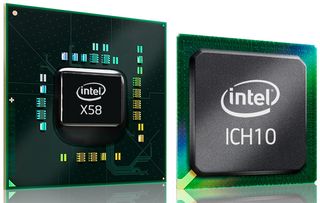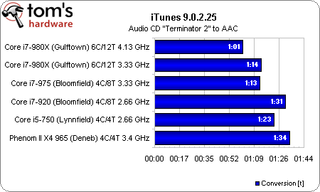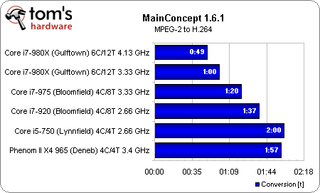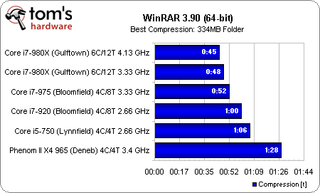Intel Core i7-980X Extreme: Hello, Six-Core Computing
Platform And Overclocking
The good news, of course, is that Core i7-980X employs the same LGA 1366 interface as Bloomfield. In fact, several vendors have already let us know that their year-old X58 boards are already working with Gulftown via updated BIOS files. So, if you’re already X58 and are looking to upgrade, you’ll likely be taken care of in the days to come as motherboard vendors update their older offerings.

No longer is there a clear segmentation, price-wise, between X58 at the high-end and P55 for mid-range folks. X58-based boards sell for as little as $160 online and we’ve seen P55 platforms in excess of $300. If you’re going for an enthusiast-class multi-GPU setup, X58 is the way to go, and a Core i7-900-series processor is your only option.

Kicking Tires, Lighting Fires
When Clarkdale hit, we were super-anxious to try our hand at overclocking the 32nm processor. I hit 4.5 GHz fairly easily in my lab with the Core i5-661. However, both Thomas and Don have since fried retail Clarkdale CPUs with too much voltage. We’re naturally a little more gun-shy about our air-cooled settings nowadays.
But Clarkdale is a bit of an enthusiast’s paradox. On one hand, that tiny dual-core die should ramp up to fairly aggressive frequencies. On the other, there’s also the 45nm graphics/memory/PCIe chip to consider—it’s essentially a waste for performance-oriented gamers who’d rather have no integrated graphics, a true integrated memory controller, and chipset-based PCI Express capable of leveraging at least 32 second-generation lanes.
Conversely, Gulftown is a purely 32nm component with the more elegant memory subsystem and the QPI interface to lots of PCIe 2.0 via X58.
Because the Core i7-980X features an unlocked clock multiplier, we were able to tune it using that ratio. Starting with a 25x default, we eventually settled on 31x, or 4.13 GHz with Enhanced SpeedStep and Turbo Boost enabled (yielding 4.26 GHz most of the time and 4.4 GHz with a single core active). This proved to be a perfectly stable configuration at 1.4V; one speed bin higher put the chip over the edge. Moreover, we achieved this using Intel's new DBX-B thermal solution, which is remarkably quiet given the load we applied to it.
Stay on the Cutting Edge
Join the experts who read Tom's Hardware for the inside track on enthusiast PC tech news — and have for over 25 years. We'll send breaking news and in-depth reviews of CPUs, GPUs, AI, maker hardware and more straight to your inbox.




As you can see, there’s quite a bit of extra performance to be had from tuning Gulftown, both in single- and multi-threaded titles. Now, a $1,000 processor might not be the ideal target for overclocking, but as the only hexa-core chip in Intel’s desktop lineup, there’s certainly something to be said for almost 1 GHz of headroom, even at the flagship position.
Then we started messing with Gulftown’s BCLK and memory settings. Bloomfield offered three channels of DDR3-1066 support, officially. Core i7-980X does as well. But a number of the memory vendors are selling these triple-channel kits rated for DDR3-2000 at 1.65V. What’s less apparent is that, when you instantiate an XMP profile for DDR3-2000, you also wind up increasing the uncore voltage from 1.2V as high as 1.7V—uncomfortably aggressive, in our opinion.

Starting with Lynnfield, however, Intel altered the ratio between the uncore and memory from 2:1 to 1.5:1. No longer would DDR-2000 memory force a 4 GHz uncore (thereby requiring those extreme voltages). Instead, you’d be looking at a 3 GHz uncore. I asked Ronak Singhal, the lead architect of Nehalem, why this change was made, and his answer was a total “duh” moment for me.
Basically, Intel dropped the ratio to allow faster memory speeds without running into the need to crank uncore voltage. “Uncore frequency is a function of the silicon bin split (just like core frequency). If we only supported 2:1, that would limit the number of products that could support a given memory frequency. This was especially important with Lynnfield/Clarksfield and getting some of the faster memory speeds to lower frequency parts, especially in mobile.”
As a result, I was able to manually configure the same Kingston kit that previously required 1.7V to run DDR3-2000 at Gulftown’s automatic 1.2V setting. Although this probably won’t make high-speed memory kits any more beneficial for overall performance (even with six cores, Gulftown isn’t hurting for bandwidth), it at least minimizes the effect of one variable in your overclocking efforts.
Current page: Platform And Overclocking
Prev Page Welcome To Gulftown Next Page Test Setup And Benchmarks-
one-shot shuffman37First Comment, I'll be staying up to read this review =)Reply
I'm guessing you didn't read this.
http://www.tomshardware.com/news/toms-hardware-reviews-news-comments,9855.html -
tipmen Hm, not bad at all more cores at the same price as 975. Games don't seem to scale that much but CAD and transcoding is improved overall. Glad to see AMDs 965 hold its own in the game segment.Reply -
one-shotI'm guessing you didn't read this.http://www.tomshardware.com/news/t ,9855.htmlNope, Haven't bothered looking at that. The 980x doesn't really make any difference in gaming but I wasn't expecting anything earth shattering. Does look good against the 965 x4 for mutlimedia applications.Reply
-
tipmen shuffman37Nope, Haven't bothered looking at that. The 980x doesn't really make any difference in gaming but I wasn't expecting anything earth shattering. Does looks good against the 965 x4 for mutlimedia applications.Reply
It is a good reminder how to act on toms you should read it when you get the chance. -
gkay09 Lolz...The Crysis benchmark and the Chris's starting line...Am sure he would have been forced to post that so that no one start with the infamous tag line "But can it play Crysis ?" :PReply -
gkay09 And Chris it would be nice if you could post some benchmarks of games that are CPU taxing like the GTA IV/ FSX...Most of the games used in the above benchmarks dont tax the CPU as much as these...Reply -
cangelini I hear you there gkay...I used to do more with GTA IV (not sure how prolific FS X still is), but it just depends on how many folks still want to see it. As a *general* rule, $1,000 CPUs aren't going to do much for your high-res gaming. However, it's a good point that there are a couple of titles notorious for hitting graphics far less than host processing power!Reply -
pinkfloydminnesota NO GTA IV? Should get great gains as it's notoriously CPU limited by the best quad cores. Unforgivable.Reply
Most Popular



